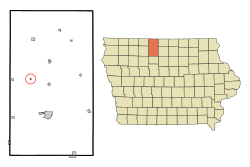Lone Rock, Iowa facts for kids
Quick facts for kids
Lone Rock, Iowa
|
|
|---|---|

Location of Lone Rock, Iowa
|
|
| Country | |
| State | |
| County | Kossuth |
| Area | |
| • Total | 0.12 sq mi (0.30 km2) |
| • Land | 0.12 sq mi (0.30 km2) |
| • Water | 0.00 sq mi (0.00 km2) |
| Elevation | 1,201 ft (366 m) |
| Population
(2020)
|
|
| • Total | 146 |
| • Density | 1,258.62/sq mi (487.18/km2) |
| Time zone | UTC-6 (Central (CST)) |
| • Summer (DST) | UTC-5 (CDT) |
| ZIP code |
50559
|
| Area code(s) | 515 |
| FIPS code | 19-46290 |
| GNIS feature ID | 0458574 |
Lone Rock is a small city in Kossuth County, Iowa, United States. In 2020, the city had a population of 146 people.
The city gets its name from a very large rock nearby. Lone Rock is known for calling itself "The Neatest Little Town in Iowa."
Contents
History of Lone Rock
Long ago, a huge 175-ton boulder was a famous landmark for travelers. People used it to find their way.
Lone Rock was officially planned in 1899. This happened when a new railroad line was being built through the area.
In 1970, the famous lone rock was moved. Workers had to blast it into four pieces. Then, they put the pieces back together inside the community.
Geography of Lone Rock
Lone Rock is located in Iowa at coordinates 43.221359 degrees North and -94.325090 degrees West.
The city covers a total area of about 0.12 square miles (0.30 square kilometers). All of this area is land.
Lone Rock is situated north of Iowa Highway B19. It is also west of U.S. Route 169.
Population and People
| Historical populations | ||
|---|---|---|
| Year | Pop. | ±% |
| 1920 | 193 | — |
| 1930 | 159 | −17.6% |
| 1940 | 170 | +6.9% |
| 1950 | 188 | +10.6% |
| 1960 | 185 | −1.6% |
| 1970 | 166 | −10.3% |
| 1980 | 169 | +1.8% |
| 1990 | 185 | +9.5% |
| 2000 | 157 | −15.1% |
| 2010 | 146 | −7.0% |
| 2020 | 146 | +0.0% |
| Source: and Iowa Data Center Source: |
||
2020 Population Details
In 2020, Lone Rock had 146 residents living in 69 households. About 43 of these were families.
Most of the people living in Lone Rock were White (90.4%). A small number were from other backgrounds or two or more races. About 3.4% of the population was Hispanic or Latino.
The average age in the city was about 53.6 years old. Many residents were 65 years or older (34.9%). About 16.4% of the people were under 20 years old.
2010 Population Details
In 2010, the city also had 146 people. There were 75 households and 47 families.
Most people were White (99.3%). A small percentage (0.7%) were from two or more races. About 1.4% of the population was Hispanic or Latino.
The average age was 56.8 years. Many people were 65 or older (32.2%). About 15.8% of residents were under 18 years old.
Education
Students in Lone Rock attend public schools operated by the North Union Community School District.
Before 2014, the area was served by the Sentral Community School District. This district joined with North Union on July 1, 2014.
See also
 In Spanish: Lone Rock (Iowa) para niños
In Spanish: Lone Rock (Iowa) para niños

